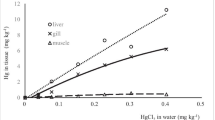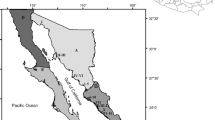Abstract
Tolerance to mercury in two populations of the grass shrimpPalaemonetes pugio was examined at different stages of this animal's life cycle. One population came from a mercury-contaminated creek, Piles Creek (PC), near industrialized Linden, New Jersey. The other population came from a relatively clean area, Big Sheepshead Creek (BSC), near non-industrialized Tuckerton, New Jersey. Larval grass shrimp showed no significant difference between populations in terms of mortality in 0.01 mg/L HgCl2, although treated BSC larvae metamorphosed significantly (P < 0.05) more slowly than their respective control group. While no BSC larvae survived the 0.0125 mg/L methylmercuric chloride (meHg) treatment, PC larvae exposed to 0.0125 mg/L meHg survived as well as their controls, indicating enhanced tolerance to meHg in this population.
Adult shrimp were exposed for 14 days to control, 0.025 mg/L meHg, 0.025 mg/L HgCl2, 0.05 mg/L meHg, or 0.05 mg/L HgCl2 PC shrimp were significantly (P < 0.05) more tolerant to both 0.025 mg/L meHg, and 0.025 mg/L HgCl2 than were the BSC adults.
Polyacrylamide gel electrophoresis suggests that both populations of shrimp are capable of producing a metallothionein like protein (MT) in response to treatment with HgCl2; MT is found in higher levels in field-caught PC shrimp than in field-caught BSC shrimp. MT was not present in field-collected, viable eggs from either population.
Similar content being viewed by others
References
Brown BE (1976) Observations on the tolerance of the isopodAsellus meridanus Rac to copper and lead. Water Res 10:555–559
Bryan GW, Humerstone LG (1971) Adaptation of the PolychaeteNereis diversicolor to estuarine sediments containing high concentrations of heavy metals. I. General observations and adaptation to copper. Mar Biol Ass UK 51:845–863
Callahan P, Weis JS (1983) Methylmercury effects on regeneration and ecdysis in fiddler crabs (Uca pugilator, U. pugnax) after short-term and chronic pre-exposure. Arch Environ Contam Toxicol 12:707–714
Connor PM (1972) Acute toxicity of heavy metals to some marine larvae. Mar Pollut Bull 4:190–192
Cubberly RN (1977) Chlorophyll concentration and species diversity in Piles Creek. MSc thesis, Montclair State College, Montclair, NJ, 65 pp
DeCoursey PC, Vernberg WB (1972) Effects of mercury on survival, metabolism and behavior of larvalUca pugilator (Brachyura). Oikos 23:241–247
Fowler SW, Heyraud M, La Rosa J (1978) Factors affecting methyl and inorganic mercury dynamics in mussels and shrimp. Mar Biol 46:267–276
Hall LW, Buikema AL (1977) Rearing larval grass shrimp in the laboratory. Prog Fish Cult 39:129–131
Hatch WR, Ott WL (1968) Determinations of submicrogram quantities of mercury by atomic absorption spectrophotometry. Anal Chem 40:2085
Hildebrand SG, Strand RH, Huckabee JW (1980) Mercury accumulation in fish and invertebrates of the North Fork of the Holston River, Virginia and Tennessee. J Environ Quality 9(3):393–400
Koepp SJ, McCormick JM, Cheng SL (1980) Distribution, flux, and biological effects of heavy metal pollution in the Newark Bay Estuary. Water Conference, Ramapo College, Mahwah, NJ: 186–201
Kraus ML (1986) Differences in tolerance to mercury between two populations of the grass shrimpPalaemonetes pugio. PhD dissertation, Rutgers Univ, Piscataway, NJ, 112 pp
Kraus ML, Kraus DB (1986) Differences in the effects of mercury on predator avoidance in two populations of the grass shrimpPalaemonetes pugio. Mar Environ Res 18:277–289
Kraus ML, Weis P, Crow JH (1986) The excretion of heavy metals by the salt marsh cord grass,Spartina alterniflora, andSpartina's role in mercury cycling. Mar Environ Res 20:307–316
Kraus ML, Weis JS (1987) Differences in the effects of mercury on telson regeneration in two populations of the grass shrimpPalaemonetes pugio. Arch Environ Contam Toxicol 17:115–120
LeBlanc GA (1982) Laboratory investigation into the development of resistance ofDaphnia magna (Straus) to environmental pollutants. Environ Pollut 27(A):309–322
Levinton JS (1980) Genetic divergence in estuaries. In: Kennedy V (ed) Estuarine Perspectives. Academic Press, New York, pp 509–520
Lowry OH, Rosenbrough NJ, Fair AL, Randall RJ (1951) Protein measurement with folin phenol reagent. J Biol Chem 193:265–275
Luoma SN (1977a) Detection of trace contaminant effects in aquatic ecosystems. J Fish Res Board Can 34:436–439
— (1977b) Physiological characteristics of mercury uptake by two estuarine species. Mar Biol 41:269–273
Luther GW, Meyerson AL, Rodgers K, Hall F (1982) Tidal and seasonal variations of sulfate ion in a New Jersey marsh system. Estuaries 5:189–196
Maisel JV (1971) Gel electrophoresis of proteins. Method Virol 5:179–246
Moraitou-Apostolopoulou M, Verriopoulous G, Lentzou P (1979) Effects of sublethal concentrations of cadmium as possible indicators of cadmium pollution in two populations ofAcartia clausi (Copepoda) living at two differently polluted areas. Bull Environ Contam Toxicol 23:642–649
Moraitou-Apostolopoulou M, Verriopoulos G, Rogdakis I (1982) Evaluation of the stress exerted by a polluted environment to a marine organism by comparative toxicity tests. Bull Environ Contam Toxicol 28:416–423
Nevo E, Perl T, Beiles A, Wool D (1981) Mercury selection of allozyme genotypes in shrimps. Experientia 37:1152–1154
Nimmo DWR, Lightner DV, Bahner LH (1977) Effects of cadmium on the shrimpsPenaeus duorarum, Palaemonetes pugio, andPalaemonetes vulgaris. In: Vernberg FJ, Calabrese AC, Thurberg FP, Vernberg WB (eds) Physiological Responses of Marine Biota to Pollutants. Academic Press, New York, pp 131–183.
Olafson RW, Sim RG, Boto KG (1979a) Isolation and chemical characterization of the heavy metal-binding protein metallothionein from marine invertebrates. Comp Biochem Physiol 62(B):407–416
Olafson RW, Kearns A, Sim RG (1979b) Heavy metal induction of metallothionein synthesis in the crabSculla serrata. Comp Biochem Physiol 62(B):417–424
Provenzano AJ, Schmilz KB, Boston MA (1978) Survival, duration of larval stages, and size of grass shrimp,Palaemonetes pugio, reared from Kepone-contaminated and uncontaminated populations in Chesapeake Bay. Estuaries 1(4):239–244
Rao KR, Conklin PJ, Doughtie DG (1985) Physiological and histopathological evaluation of toxicity of hexavalent chromium to the grass shrimpPalaemonetes pugio Holthuis In: Vernberg FJ, Thurberg FP, Calabrese A, Vernberg WB (eds) Marine Pollution and Physiology: Recent Advances. University of South Carolina Press, pp 131–183
Ray GL, Tripp MR (1976) The uptake of mercury from water by the grass shrimp,Palaemonetes vulgaris (Say). J Environ Quality 5(2): 193–197
Ray S, McLeese D, Pezzack D (1980) Accumulation of cadmium byNereis virens. Arch Environ Contam Toxicol 9:1–8
Renna MS (1982) The effect of polluted water and methylmercury on fin regeneration and swimming stamina of killifish (Fundulus heteroclitus): A comparison between two populations. MSc Thesis, Rutgers Univ, Newark, NJ, 64 pp
Roesijadi G, Petrocelli, SR, Anderson, JW, Giam, CS, Neff GE (1976) Toxicity of polychlorinated biphenyls (Aroclor® 1254) to adult, juvenile, and larval stages of the shrimpPalaemonetes pugio. Bull Environ Contam Toxicol 15(3):297–304
Saliba LJ, Ahsanullah M (1973) Acclimation and tolerance ofAnemia salina andOphryotrocha labronica to copper sulphate. Mar Biol 23:297–302
Saliba LJ, Krzyz RM (1976) Acclimation and tolerance ofArtemia salina to copper salts. Mar Biol 38:231–238
SAS User's Guide: Statistics, 1982 edition: SAS Institute Inc, Cary, NC
Shealy MH, Sandifer PA (1975) Effects of mercury on survival of the larval grass shrimpPalaemonetes vulgaris. Mar Biol 33:7–16
Sheffy TB (1978) Mercury burdens in crayfish from the Wisconsin River. Environ Pollut 17:220–225
Sloan JP, Thompson AJ, Larkin PA (1974) The biological half-life of inorganic mercury in the Dungeness crab (Cancer magister). J Fish Res Board Can 10:1571–1576.
Tatem HE, Anderson JW, Neff GM (1976) Seasonal and laboratory variations in the health of grass shrimpPalaemonetes pugio: Dodecyl sodium sulfate bioassay. Bull Environ Contam Toxicol 16(3):368–375
Verriopoulos G, Moraotou-Apostolopoulou M (1982) Differentiation of the sensitivity to copper and cadmium in different life stages of a copepod. Mar Pollut Bull 13(4):123–125
Weis JS, Weis P, Heber M, Vaidya S (1981) Methylmercury tolerance of killifish (Fundulus heteroclitus) embryos from a polluted vs non-polluted environment. Mar Biot 65:283–287
Weis JS, Weis P (1984) A rapid change in methylmercury tolerance in a population of killifish, (Fundulus heteroclitus), from a golf course pond. Mar Environ Res 13:231–245
Weis JS, Renna M, Vaidya S, Weis P (1987) Mercury tolerance in killifish: a stage-specific phenomenon In: Capuzzo JM, Rester DR (eds) Oceanic Processes in Marine Pollution: Volume I Biological Processes and Wastes in the Ocean. Krieger Publ Co, Malabar, FL, pp 31–36
Weis P (1984) Metallothionein and mercury tolerance in the killifish,Fundulus heteroclitus. Mar Environ Res 14:153–166
Wiedow MA, Kneip TJ, Garte SF (1982) Cadmium-binding proteins from blue crabs (Callinectes sapidus) environmentally exposed to cadmium. Environ Res 28:164–170
Author information
Authors and Affiliations
Rights and permissions
About this article
Cite this article
Kraus, M.L., Weis, J.S. & Weis, P. Effects of mercury on larval and adult grass shrimp (Palaemonetes pugio). Arch. Environ. Contam. Toxicol. 17, 355–363 (1988). https://doi.org/10.1007/BF01055173
Received:
Revised:
Issue Date:
DOI: https://doi.org/10.1007/BF01055173




